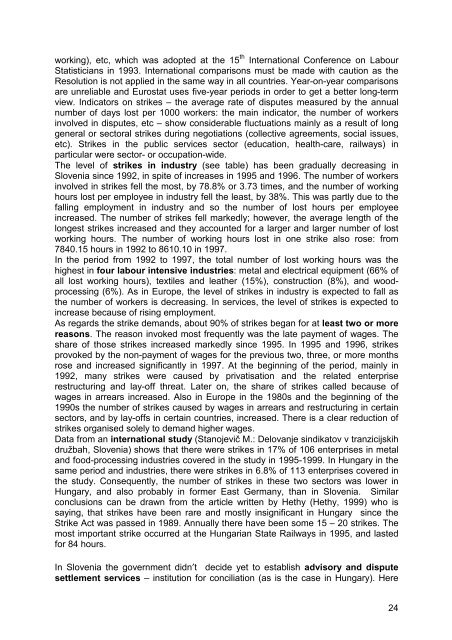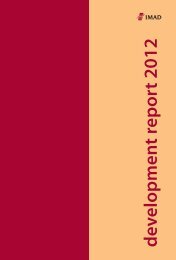The Development of New Industrial Relations in Slovenia - UMAR
The Development of New Industrial Relations in Slovenia - UMAR
The Development of New Industrial Relations in Slovenia - UMAR
You also want an ePaper? Increase the reach of your titles
YUMPU automatically turns print PDFs into web optimized ePapers that Google loves.
work<strong>in</strong>g), etc, which was adopted at the 15 th International Conference on Labour<br />
Statisticians <strong>in</strong> 1993. International comparisons must be made with caution as the<br />
Resolution is not applied <strong>in</strong> the same way <strong>in</strong> all countries. Year-on-year comparisons<br />
are unreliable and Eurostat uses five-year periods <strong>in</strong> order to get a better long-term<br />
view. Indicators on strikes – the average rate <strong>of</strong> disputes measured by the annual<br />
number <strong>of</strong> days lost per 1000 workers: the ma<strong>in</strong> <strong>in</strong>dicator, the number <strong>of</strong> workers<br />
<strong>in</strong>volved <strong>in</strong> disputes, etc – show considerable fluctuations ma<strong>in</strong>ly as a result <strong>of</strong> long<br />
general or sectoral strikes dur<strong>in</strong>g negotiations (collective agreements, social issues,<br />
etc). Strikes <strong>in</strong> the public services sector (education, health-care, railways) <strong>in</strong><br />
particular were sector- or occupation-wide.<br />
<strong>The</strong> level <strong>of</strong> strikes <strong>in</strong> <strong>in</strong>dustry (see table) has been gradually decreas<strong>in</strong>g <strong>in</strong><br />
<strong>Slovenia</strong> s<strong>in</strong>ce 1992, <strong>in</strong> spite <strong>of</strong> <strong>in</strong>creases <strong>in</strong> 1995 and 1996. <strong>The</strong> number <strong>of</strong> workers<br />
<strong>in</strong>volved <strong>in</strong> strikes fell the most, by 78.8% or 3.73 times, and the number <strong>of</strong> work<strong>in</strong>g<br />
hours lost per employee <strong>in</strong> <strong>in</strong>dustry fell the least, by 38%. This was partly due to the<br />
fall<strong>in</strong>g employment <strong>in</strong> <strong>in</strong>dustry and so the number <strong>of</strong> lost hours per employee<br />
<strong>in</strong>creased. <strong>The</strong> number <strong>of</strong> strikes fell markedly; however, the average length <strong>of</strong> the<br />
longest strikes <strong>in</strong>creased and they accounted for a larger and larger number <strong>of</strong> lost<br />
work<strong>in</strong>g hours. <strong>The</strong> number <strong>of</strong> work<strong>in</strong>g hours lost <strong>in</strong> one strike also rose: from<br />
7840.15 hours <strong>in</strong> 1992 to 8610.10 <strong>in</strong> 1997.<br />
In the period from 1992 to 1997, the total number <strong>of</strong> lost work<strong>in</strong>g hours was the<br />
highest <strong>in</strong> four labour <strong>in</strong>tensive <strong>in</strong>dustries: metal and electrical equipment (66% <strong>of</strong><br />
all lost work<strong>in</strong>g hours), textiles and leather (15%), construction (8%), and woodprocess<strong>in</strong>g<br />
(6%). As <strong>in</strong> Europe, the level <strong>of</strong> strikes <strong>in</strong> <strong>in</strong>dustry is expected to fall as<br />
the number <strong>of</strong> workers is decreas<strong>in</strong>g. In services, the level <strong>of</strong> strikes is expected to<br />
<strong>in</strong>crease because <strong>of</strong> ris<strong>in</strong>g employment.<br />
As regards the strike demands, about 90% <strong>of</strong> strikes began for at least two or more<br />
reasons. <strong>The</strong> reason <strong>in</strong>voked most frequently was the late payment <strong>of</strong> wages. <strong>The</strong><br />
share <strong>of</strong> those strikes <strong>in</strong>creased markedly s<strong>in</strong>ce 1995. In 1995 and 1996, strikes<br />
provoked by the non-payment <strong>of</strong> wages for the previous two, three, or more months<br />
rose and <strong>in</strong>creased significantly <strong>in</strong> 1997. At the beg<strong>in</strong>n<strong>in</strong>g <strong>of</strong> the period, ma<strong>in</strong>ly <strong>in</strong><br />
1992, many strikes were caused by privatisation and the related enterprise<br />
restructur<strong>in</strong>g and lay-<strong>of</strong>f threat. Later on, the share <strong>of</strong> strikes called because <strong>of</strong><br />
wages <strong>in</strong> arrears <strong>in</strong>creased. Also <strong>in</strong> Europe <strong>in</strong> the 1980s and the beg<strong>in</strong>n<strong>in</strong>g <strong>of</strong> the<br />
1990s the number <strong>of</strong> strikes caused by wages <strong>in</strong> arrears and restructur<strong>in</strong>g <strong>in</strong> certa<strong>in</strong><br />
sectors, and by lay-<strong>of</strong>fs <strong>in</strong> certa<strong>in</strong> countries, <strong>in</strong>creased. <strong>The</strong>re is a clear reduction <strong>of</strong><br />
strikes organised solely to demand higher wages.<br />
Data from an <strong>in</strong>ternational study (Stanojevič M.: Delovanje s<strong>in</strong>dikatov v tranzicijskih<br />
družbah, <strong>Slovenia</strong>) shows that there were strikes <strong>in</strong> 17% <strong>of</strong> 106 enterprises <strong>in</strong> metal<br />
and food-process<strong>in</strong>g <strong>in</strong>dustries covered <strong>in</strong> the study <strong>in</strong> 1995-1999. In Hungary <strong>in</strong> the<br />
same period and <strong>in</strong>dustries, there were strikes <strong>in</strong> 6.8% <strong>of</strong> 113 enterprises covered <strong>in</strong><br />
the study. Consequently, the number <strong>of</strong> strikes <strong>in</strong> these two sectors was lower <strong>in</strong><br />
Hungary, and also probably <strong>in</strong> former East Germany, than <strong>in</strong> <strong>Slovenia</strong>. Similar<br />
conclusions can be drawn from the article written by Hethy (Hethy, 1999) who is<br />
say<strong>in</strong>g, that strikes have been rare and mostly <strong>in</strong>significant <strong>in</strong> Hungary s<strong>in</strong>ce the<br />
Strike Act was passed <strong>in</strong> 1989. Annually there have been some 15 – 20 strikes. <strong>The</strong><br />
most important strike occurred at the Hungarian State Railways <strong>in</strong> 1995, and lasted<br />
for 84 hours.<br />
In <strong>Slovenia</strong> the government didn′t decide yet to establish advisory and dispute<br />
settlement services – <strong>in</strong>stitution for conciliation (as is the case <strong>in</strong> Hungary). Here<br />
24
















